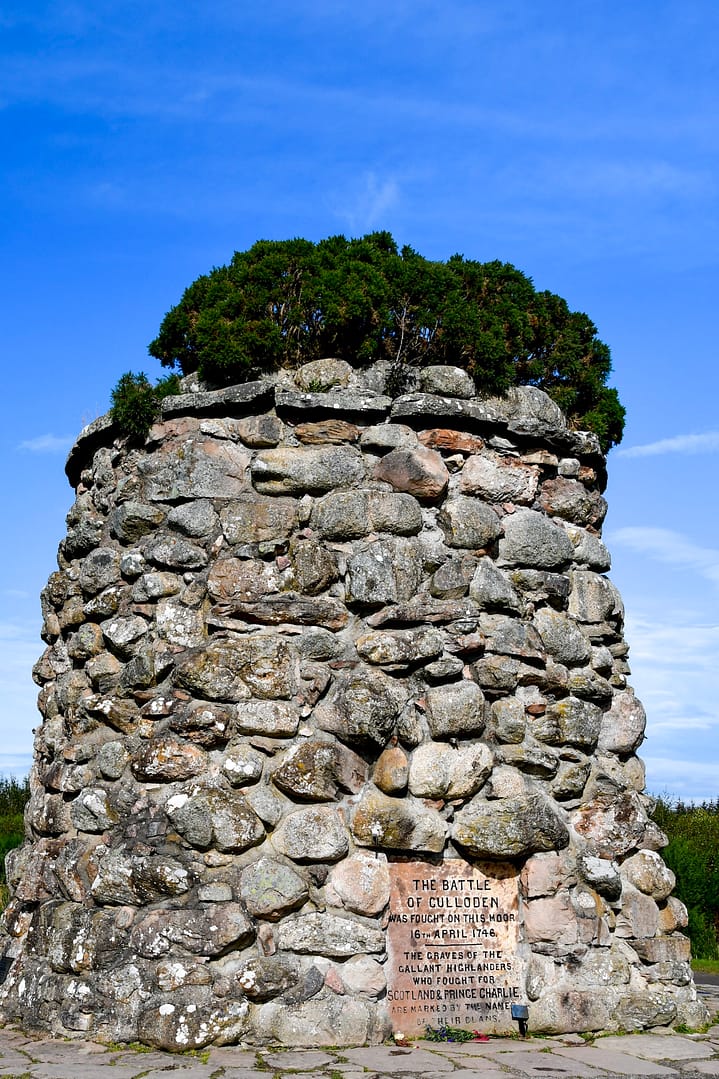We left Inverness with the destination of Speyside, home of castles and single malt scotch. After walking 96.5 miles on the West Highland Way, we were happy to engage in less demanding holiday activities by visiting Culloden Moor and Cawdor Castle. https://hikescape.org/whw-tyndrum-kingshouse-kinlochleven-fort-william/

Culloden Moor is a historical memorial site of the 1745 battle between Scottish Jacobites and English government forces. Over 1500 Highlanders from many clans were slaughtered on this moor, and summarily buried in mass graves with their kinsmen.

The visitors center was very informative, presenting the perspectives of both Jacobites on one side of the exhibits, and the English government on the other.

The moor was beautiful, with depictions showing the front lines where clansmen lined up to charge and fight. No quarter was given to the Highlanders who survived- all were shot. The repercussions of the Rising lasted for many years until Queen Victoria showed an interest in Scottish culture and heritage.

Cawdor Castle: History, gardens, art
Our next stop was Cawdor Castle, dating from the 14th century. The castle was acquired when the heiress of the Calder family (Cawdor) was kidnapped by the Campbells. She became the bride of the Earl of Argyll at the age of twelve- in the year 1510.
https://www.thecastlesofscotland.co.uk/the-best-castles/grand-castles/cawdor-castle/

I love the worn stone treads that show centuries of use. Cawdor Castle has remained in the Campbell family since 1510. It feels very authentic because such care has been taken to preserve the interior, even as additions occurred. The original tapestries from the 14th century cover the stone walls- and during this time, the tapestries have not been moved. We talked to a young man employed by the Scotland National Trust. He was well versed on the Scottish castle architecture, art and other information not available on the audio tour or signage.

The castle was built around what was later determined to be a holly tree long deceased, but well preserved. There are hidden passageways and rooms, some of which were discovered in the last century. Cawdor Castle houses an impressive art collection of medieval works, along with French impressionists and Picassos.

We also met a gentleman on the grounds who said that the castle’s current inhabitant is the second wife of the now-deceased Earl, and she inherited Cawdor Castle rather than the eldest son. The privileges of wealth and inheritance can have an ironic twist, I suppose.

Cawdor Castle gardens
in addition to the gorgeous art and fascinating history, the gardens were still a riot of colorful blooms in late September. The Minotaur stands guard over the labyrinth, which unfortunately was closed, citing the fragility of the root system of the hollies forming the maze.

There were more delights at each turn of the formal gardens of Cawdor Castle.


The garden sculptures were another example of the diverse collection of art displayed at Cawdor Castle.


We ended our tour in the gardens and set out on the woodland paths to walk about six and a half miles. It was an idyllic setting in a maelstrom of historic- and perhaps current- blood lust.


Thanks for being a part of our journey. We have a few more days of castle tours, castle ruins, scotch tastings and the gorgeous Scottish countryside. Then we return home to our pups and cats, and the seasonal delights of autumn in our beautiful Appalachian mountains.



1 Comment
Scottish castles and single malt whiskies - HIKEscape · October 1, 2019 at 1:05 am
Comments are closed.